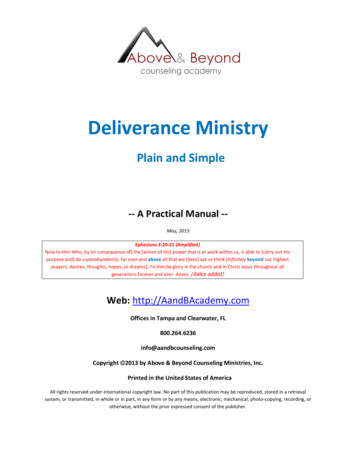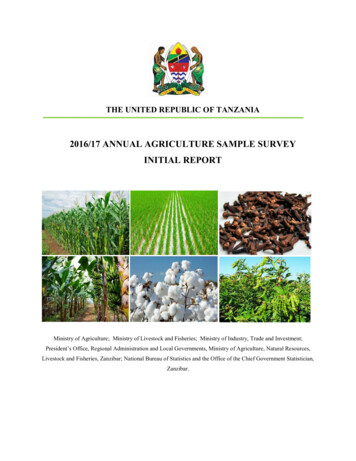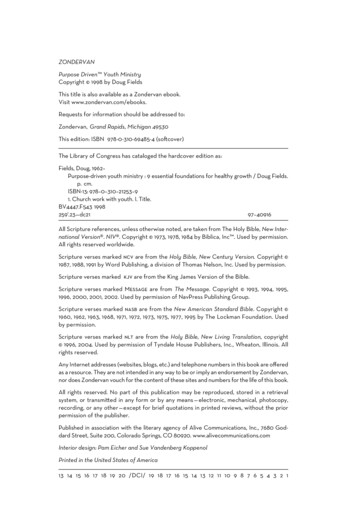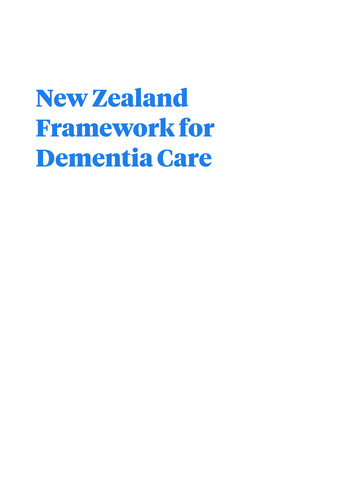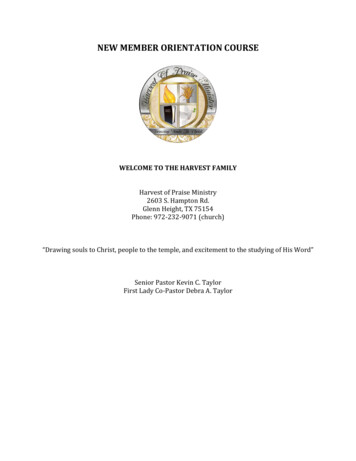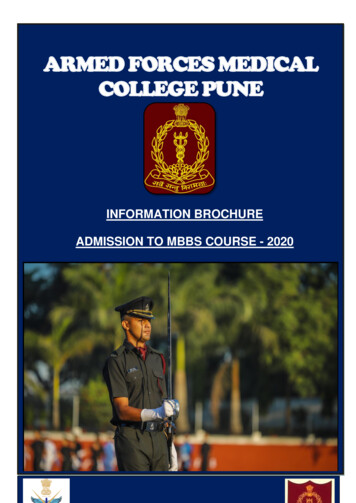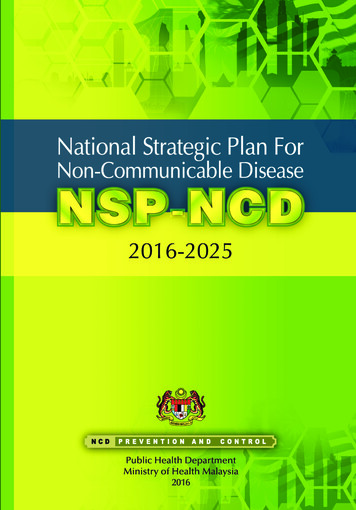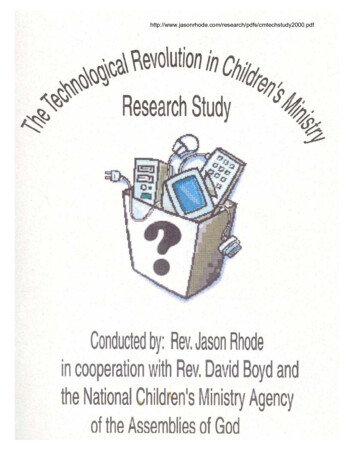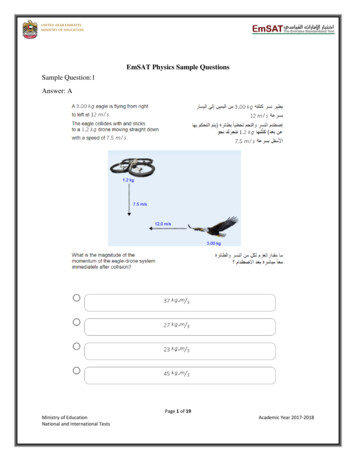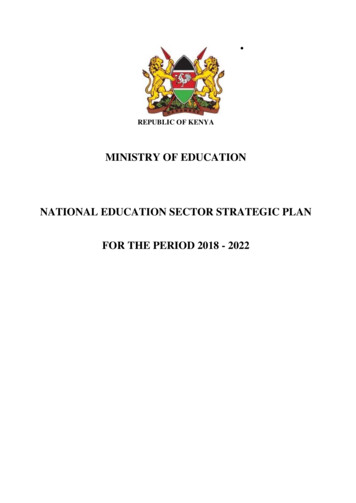
Transcription
REPUBLIC OF KENYAMINISTRY OF EDUCATIONNATIONAL EDUCATION SECTOR STRATEGIC PLANFOR THE PERIOD 2018 - 2022
VISIONQuality and inclusive education, training and research for sustainabledevelopmentMISSIONTo provide, promote and coordinate competence based equitable learnercentred education, training and research for sustainable developmentTHEMESAccess and Equity; Quality and Relevance; Governance and Accountability2
ContentsContentsList of TablesList of FiguresLIST OF ACRONYMS AND ABBREVIATIONSFOREWORDPREFACE AND ACKNOWLEDGEMENTEXECUTIVE SUMMARYDEFINITION OF TERMS1. 151.1151.2161.3161.4171.5182. .1342.5.2352.5.3352.5.4362.5.5372.6372.7383. iviiixxiii
63.2.12883.2.13903.2.14914. Error! Bookmark not defined.4.1Error! Bookmark not defined.4.2Error! Bookmark not defined.4.3Error! Bookmark not defined.5. Error! Bookmark not 6. 106Annex 1: Kenya Education Sector AnalysisAnnex 2: Multiyear Action PlanAnnex 3: Logical FrameworkAnnex 4: Participants to the ESA and NESSP development4113113113113
List of TablesTable 1: Total Population and Gross Domestic Product, 2013-2018Table 2: Government Resources and SpendingTable 3: Kenya Basic Social IndicatorsTable 4: Refugee Children Enrolment by Location and Level of EducationTable 5: Trends in Pre-primary Sub-SectorTable 6: Trends in Primary Sub-SectorTable 7: Trends in Secondary Education Sub-SectorTable 8: Enrolment Trends in TVET 2013-2018Table 9: Enrolment by Gender in Universities (2013/14 - 2016/17)Table 10: Quality and Relevance of EducationTable 11: Graduates from Teacher Training CollegesTable 12: Net Projections on Teacher Shortages -2019-2023Table 13: Teachers Employed by Boards of ManagementTable 14: Government Expenditure on Education, 2010/11-2015/16 (Current Prices)Table 15: Macroeconomic ForecastTable 16: Simulation Parameters and ResultsTable 17: Total Resource RequirementsTable 18: Summary of Recurrent CostsTable 19: System Strengthening Costs by Delivery UnitTable 20: Summary of Capital CostsTable 21: Resource Requirements and Financing Gap for the Education SectorTable 22: Recurrent Resource Requirements and Financing Gap for Education SectorTable 23: Recurrent resource Requirements and Financing Gap for Basic EducationTable 24: Possible Risks and Mitigation 4105105106111
List of FiguresFigure 1: Structure of the New Education System in KenyaFigure 2: Adult and Continuing Education Enrolments Trends in KenyaFigure 3: Trends in Survival Rates and Promotion and Repetition RatesFigure 4: Out of School by County in Thousands, 2014Figure 5: Disparities in Retention by Selected CountiesFigure 6: Trends in KCSE PerformanceFigure 7: The Causal Chain of NESSP 2018-2022Figure 8: Evolution of Enrolments in Pre-primary and PrimaryFigure 9: Evolution of Enrolments in Secondary and Tertiary Levels of Education67132121232537101102
LIST OF ACRONYMS AND CR:VET:Adult and Continuing EducationBiosafety Appeals BoardBillionsCentre for Mathematics, Science and Technology Education in AfricaCabinet SecretaryCurriculum Support OfficersCommission for University EducationEducation Assessment and Resource CentresEarly Childhood Development and EducationFull Time EquivalentGross Domestic ProductGross Enrolment RateGross Expenditure on Research and DevelopmentGovernment of KenyaGender Parity IndexHuman Development Index (HDI)Higher Education Loans BoardKenya ShillingsKenya Early Years AssessmentKenya Certificate of Primary EducationKenya National Adult Literacy SurveyKenya National Qualifications AuthorityKenya Certificate of Secondary EducationKenya Universities and Colleges Central Placement ServiceNational Commission for Science, Technology and InnovationNet Enrolment RateNational Research FundThe Pan African University of Science, Technology and InnovationPrimary School Education AssessmentPopulation and Housing CensusSemi-Autonomous Government AgenciesScience Technology and InnovationScience Technology Engineering and MathematicsTeacher Performance Appraisal and DevelopmentTeacher Professional DevelopmentTechnical Vocational Education and TrainingTechnical and Vocational Education and Training AuthorityUniversities Funding BoardUnited Nations High Commissioner for RefugeesVocational Education and Training7
FOREWORDThe Government of Kenya is committed to ensuring that no child is left behind in terms ofaccess to education. Articles 43(f) and 53(1) (b) of the Kenyan Constitution provide for theright to education and the right to free and compulsory basic education, respectively. TheBasic Education Act (2013) guarantees the right of every child to free and compulsory basiceducation. The government is also committed to implementing international and regionalcommitments related to education, such as the Education for All (EFA) goals and SustainableDevelopment Goals (SDGs), among others. In order to honour the above commitments, theMinistry of Education is committed to providing and promoting competence based andequitable learner centred education, training and research for sustainable development. It isimportant to note that the Government of Kenya continues to invest heavily in the educationsector, committing about 5.4% of GDP to the sector.This National Education Sector Strategic Plan (NESSP) 2018-2022 is an all-inclusive, sectorwide plan that spells out policy priorities, programmes and strategies for the education sectorover the next five years. NESSP (2018-2022) builds on the successes and challenges of theNational Education Sector Plan (NESP) 2013-2017. The Plan aims at achieving fourimportant strategic objectives for education, training and research, which are: to enhanceaccess and equity; to provide quality and competence based education, training and research;to strengthen management, governance and accountability; and enhance relevance andcapacities for Science, Technology and Innovation (ST&I) in education, training, andresearch for labour markets. The achievement of these strategic objectives will contribute tothe realization of the aspirations of Kenya’s blueprint, the Vision 2030 (as well as the MTPIII which provides direction on planning and investments of the Vision 2030 during theperiod 2018-2022).The programmes identified in NESSP 2018-2022 are drawn from the education sectoranalysis, the lessons learnt from the implementation of the National Education Sector Plan(2013-2017), the Sessional Paper No 1 of 2019 and priorities identified in the Medium TermPlan III. This sector plan is a product of a highly participatory and consultative processbringing together representatives from all the State Departments; the Teachers ServiceCommission; Semi-Autonomous Government Agencies (SAGAs) in the Ministry ofEducation; development partners, through the Education Development Partners CoordinationGroup (EDPCG); Civil Society Organisation(s); and research institutions, led by the Ministryof Education.Prof. George A. O. Magoha, EGH, MBS, EBS, CBSCabinet Secretary, Ministry of Education8
PREFACE AND ACKNOWLEDGEMENTThe provision of quality education and training to all Kenyans is fundamental to thegovernment's overall strategy for socio-economic development. Consequently, reforms in theeducation sector are necessary for the achievement of Kenya Vision 2030 and meeting theprovisions of the Kenya Constitution 2010 in terms of human resource capital to supportprovision of high quality life for all citizens. This National Education Sector Strategic Plan(NESSP) is a sector wide reform programme that gives effect to the legislative frameworksdeveloped to actualize the Sessional Paper No. 1 of 2019.The NESSP 2018-2022, has been developed through an all-inclusive stakeholder consultativeprocess. Through NESSP (2018-2022), Kenya strives to provide quality and inclusiveeducation, training and research for sustainable development. This will be realised throughproviding, promoting and coordinating competency based equitable learner centrededucation, training and research that is relevant to the labour market. This plan purposes toincrease access and participation, raise the quality and relevance and improve governance andaccountability in education, training and research with an emphasis on Science, Technologyand Innovation.The NESSP 2018-2022 is a five-year plan that outlines the education sector reformimplementation agenda in five thematic areas. The thematic areas include Access andparticipation; Equity and inclusiveness; Quality and Relevance; Sector Governance andAccountability; and Pertinent and Contemporary Issues and Values. Each of the thematicareas is further divided into policy priority, programmes and activities. An implementationplan in the form of a NESSP Results Framework has been developed detailing the outputsfrom the activities, targeted quantities and the respective financial implication. In addition, amonitoring and evaluation framework has been developed to enable tracking and reportingthe implementation of the plan.The implementation of the plan will be done under a multi sectoral approach with all therelevant stakeholders. For effective alignment and delivery, a NESSP Co-ordination Unit, inthe form of a multi-agency secretariat will spearhead the implementation of this plan. TheNESSP Co-ordination unit will report progress according to the NESSP Results Frameworkand the Monitoring and Evaluation Framework.Financing of the plan will be a joint effort among national government, county governments,development partners, private sector and households. This calls for strengthening ofcoordination, linkages and collaboration among all the players to mobilise the requisitefinancial resources. The Government will continue strengthening governance andaccountability to ensure value for money.We wish to acknowledge the role played by the NESSP Technical Working Team and othercolleagues in the sector in the conceptualisation and development of this sector plan. We9
would also like to thank the development partners, academics, and civil society organisationsfor their contributions to the development of this Plan. We call upon all players in Kenya’seducation, training and research sector to support this innovative National Education SectorStrategic Plan.Prof. Collette SudaCAS & PrincipalSecretary, StateDepartment of UniversityEducation and ResearchDr. Belio KipsangPrincipal Secretary,State Department ofEarly Learning andBasic EducationDr. Kevit DesaiPrincipal Secretary,State Department ofVocational andTechnical Training10Mr. Alfred CheruiyotPrincipal Secretary,State Department ofPost Training andSkills Development
EXECUTIVE SUMMARYThis NESSP 2018-2022 outlines policy priorities, programmes and strategies for the Ministryof Education over the next five years. It covers the following sub-sectors: Pre-PrimaryEducation, Primary Education, Secondary, Adult and Continuing Education, Technical andVocational Education and Training (TVET), University Education, Special Needs Education,and Teacher Education. There are also programmes related to National QualificationsFramework, Quality Assurance and Standards, as well as Science, Technology andInnovations. The Plan is divided into five chapters.The first chapter provides an analysis of issues that have an implication on education inKenya, including Kenya’s demographic, macro-economic and social indicators, as well as thehumanitarian context. Four in every ten Kenyans are of pre-school, primary and secondaryschool going age (that is age 4-17 years). In relation to the economy, the size of the economyhas grown from GDP of about KES 4.8 trillion in 2013 to about KES 8.9 trillion in 2018.There are also improvements in a number of social indicators. For instance, Kenya’s HumanDevelopment Index (HDI) increased from 0.53 in 2010 to 0.555 in 2015 and further to 0.59in 2017 with life expectancy at birth increasing from 62.9 years in 2010 to 66.6 years in 2015and 67.3 years in 2017. Kenya is also ranked as one of the countries with the highest numberof refugees, with close to 155,000 school going children among them.Chapter 2 provides a summary of the trends in education based on the Education SectorAnalysis (ESA). Central government spending on education is about 5.3 percent of GDP. Alarge share, about 92 percent of this expenditure, goes to recurrent expenditure. In terms ofaccess to education, the country has made strides. The number of Pre-Primary centres rosefrom 40,145 centres in 2012 to 41,779 centres in 2018. The enrolment in Pre-primaryeducation increased from 2,865,348 in 2013 to 3,390,545 in 2018. The Gross Enrolment Rate(GER) in pre-primary education stood at 75.4 % in 2018 while the net enrolment rate was at77.2% during the same year.At primary school level, the number of primary schools increased from 28,026 in 2013 to37,910 in 2018, with enrolment rising from 9.8 million in 2013 to about 10.5 million pupilsin 2018. This growth translated to a reduction in GER from 105% to 104% in primary schooleducation, while NER increased from 88.1% in 2013 to 92.4% in in 2018. On gender parity,the government investment in primary education has resulted to improved parity index from0.96 in 2013 to 0.97 in 2018. The completion rate of primary education has also increasedconsiderably from 80% in 2013 to 84.2% in 2018, while the retention rate increased from77% to 86% during the same period.The number of secondary schools increased from 8,734 to 11,399, while enrolment insecondary education grew from 2 million to 2.9 million during the period 2013 to 2018. Asoutlined in the Education Sector Analysis (ESA), the GER increased from 54.3% in 2013 to70.3% in 2018 while NER increased from 38.5% to 53.2% during the same period. Thegender parity now stands at 0.95 in 2018.11
Technical and Vocational Education and Training (TVET) has experienced remarkablegrowth over the last five years. The number of TVET institutions increased from 700 in 2013to 1,300 in 2018. Over the same period, enrolment grew by 92.5% from 148,009 in 2013 to363,884 in 2018. The gender parity index improved from 0.68 in 2013 to 0.78 in 2018.The university sub-sector has witnessed growth in the last 5 years due to establishment ofnew universities and expansion of the existing ones. The number of universities increasedfrom 57 in 2012 to 74 in 2018. The total university student enrolment increased by 48.8%from 361,379 in 2013 to 537,733 in 2018. The enrolment by gender was 310,367 (57.7%)male and 227,356 (42.35) female in 2018. Student enrolment, by gender, in public andprivate universities, from 2013/14 to 2016/17, shows that gender parity stood at 68.89% in2014, 68.63% in 2015, 71.48% in 2016 and decreased to 70.86% in 2017.Despite this, the country faces a number of challenges in the sector. At the basic educationlevel, there are important sources of internal inefficiencies. For instance, more than 40percent of children who start Grade 1 do not go up to Form 4. Another thing is that anestimated 1 million school going children are out of school, mostly in ASAL counties. Thereare also wide disparities in access to education, based on gender, location and region. Forinstance, girls are generally left behind in ASAL areas. Another aspect is that nearly 6 out of10 children from the poorest quintile, who enrolled in Grade 1, are expected to completeGrade 6, compared to 9 out of 10 children from the richest quintile. Another challenge is thatmore children at basic education level are entering school but not adequately learning. Inrelation to performance, less than 20 percent of the candidates sitting for KCSE exams scoredC and above over the last two academic years, which is the entry qualification for universityeducation.The TVET and university sub-sectors face a number of challenges too. The challenges ofTVET include inadequate data, low enrolment among females, poor linkages with theindustry, inadequate physical infrastructure and equipment to support the teaching of theCompetency Based Education and Training (CBET) curriculum, non-alignment of thecurriculum to the CBET curriculum and to the Vision 2030, among others. The universitysub-sector, on the other hand, faces a number of challenges such as inadequate funding, lowproportion of Science Engineering and Technology (SET) subjects, low enrolment of femalestudents in SET subjects, and inadequate qualified teaching staff, among others.The policy priorities, goals and programmes identified in this Plan, for each sub-sector, arebased on the following thematic areas: access and equity; education quality and relevance;education management, governance and accountability; and labour market relevance. Thechoice of these thematic areas is based on the challenges facing the education sector inKenya, as identified in the Kenya Education Sector Analysis; the priorities identified in theVision 2030’s third Medium Term Plan as well as extensive consultations with educationstakeholders in Kenya. The actual programme design, discussed in Chapter 3 of the Plan, has,at the top, that is the policy priority level, the goal or general objective that addresses a givenidentified challenge and is linked to a target as an expected outcome within the resultsframework. Within each goal or general objective, there are a number of programmes thataddress the underlying causes of the identified challenge, linked to a target as an intermediate12
outcome within the results framework. Finally, within each programme, there is a set ofactivities outlined to address the underlying challenges identified. The activities, within theresults framework, are like output indicators.The programmes and their associated activities are projected to cumulatively cost KES 2.985trillion over the 5-year period, with recurrent costs projected to account for about 90 percentof the total projected cost. This projected cost, discussed in Chapter 4, is based on theambitious increment in enrolment at all levels of education, and the desire to roll out thecompetence based curriculum coupled with the strengthening of the system for qualityservice delivery. The education sector is likely to receive, cumulatively, KES 2.32 trillion inbudget over the 5-year plan period against the plan cost of KES 2.985 trillion. Without takinginto account commitments from development partners, the resource gap is therefore projectedto be KES 666 billion (USD 6.66 billion) over the 5-year period.The Plan will be implemented through the existing structures of the Ministry of Education.As identified in the sector diagnosis, the non-alignment of systems and institutions in thesector stands out as a threat to the implementation of this Plan. The Plan, therefore, proposesthe creation of the NESSP Co-ordination Unit, which will take the form of a multi-agencysecretariat, to spearhead the implementation of this Plan. The NESSP Co-ordination Unit willbe accountable to the Principal Secretaries of the four State Departments. It will reportregularly to the Cabinet Secretary, through the Principal Secretaries, about progressaccording to the NESSP Results Framework and the Monitoring and Evaluation Framework.13
DEFINITION OF TERMSAssessments:Wide variety of methods and tools that educators use to evaluate,measure and document the academic readiness progress, skillsacquisition or educational needs of studentsAccreditation:Process of validation in which colleges, universities and otherinstitutions of higher learning are evaluatedGuidelines:Recommended practices that organisations should undertake to meetset standardsQuality Education:One that provides all learners with capabilities they require tobecome economically productive, develop sustainable livelihoods,contribute to peaceful and democratic societies and enhanceindividual wellbeingRefugee:A person who (a) owing to a well-founded fear of being persecutedfor reasons of race, religion, sex, nationality, membership of aparticular social group or political opinion is outside the country ofhis nationality and is unable or, owing to such fear, is unwilling toavail himself of the protection of that country; or (b) not having anationality and being outside the country of his former habitualresidence, is unable or, owing to a well-founded fear of beingpersecuted for any of the aforesaid reasons, is unwilling to return toitSummativeEvaluation:A process designed to evaluate a student’s learning, skill acquisitionand academic achievement at the conclusion of a definedinstructional periodFormative Evaluation:A process designed to progressively evaluate a student’scomprehension, learning needs and academic progress during theinstructional periodMarginalized Groups:Groups that have been socially disadvantaged and relegated to thefringe of society and denied involvement in mainstream economic,political, cultural and social activitiesEducationAssessment andResource Centres:Education Assessment and Resource Centres are supposed to playthe role of identifying, assessing and placing children with specialneeds in education and disabilities.14
1. THECONTEXT OFREFORM IN KENYAEDUCATIONALDEVELOPMENTAND1.1 Key Demographic and Macro Economic IndicatorsKenya is bordered by Tanzania to the south and southwest, Uganda to the west, South Sudanto the north-west, Ethiopia to the north and Somalia the north-east. It covers 581,309 km2.Swahili is the national language of Kenya and the first official language, spoken by nearly allthe population. The country’s long-term development goals are set out in Vision 2030, whichaims to transform Kenya into a newly industrializing, middle-income country providing ahigh quality of life to all its citizens by 2030 in a clean and secure environment.Four in every ten Kenyans are aged 4-17 and are of pre-primary, primary and secondaryschool going age. Table 1 presents the evolution of total population and Gross DomesticProduct. As at 2018, Kenya’s population was estimated at 47.8 million, reflecting a 14.4percent growth rate between 2013 and 2018. The official school age in Kenya is classified asfollows: 3-5 for ECDE, 6-13 for primary and 14-17 for secondary. As Table 1 shows, almostfour in every ten Kenyans are of school going age. The school-age population grew by almost13 percent between 2013 and 2018. This has an implication on the provision of education andemployment opportunities for young people in the country.Table 1: Total Population and Gross Domestic Product, 2013-2018PopulationTotal Population (Million)Population (3-17) (Million)3-17 as % of total populationGross Domestic ProductGDP, Market Prices (KES Bn)GDP Growth, Constant PricesGDP per capita current (KES)GDP per capita constant Source: Economic Surveys, *ProvisionalKenya’s economy recorded a relatively steady growth over the period 2013-2018. Theeconomy increased by 88 percent, from a GDP (market prices) of close to KES. 4.8 trillion in2013 to about KES. 9 trillion in 2018. Real GDP annual growth rate averaged 5.6 percent,increasing from 5.7 percent in 2016 to 6.3 percent in 2018. The average wealth of Kenyansincreased steadily over the period under review. In real terms, the GDP per capita increasedby 15 percent, from about KES. 87,000 in 2013 to around KES. 100,000 in 2018. Table 2shows Kenya’s fiscal outturn over the years 2014 to 2018. Revenues including grants, as ashare of GDP, have remained constant- marginally increasing from 21.1 percent in 2014 to21.2 in 2018. Total national government expenditures, as a share of GDP, did not alsosignificantly change- reducing marginally from about 36.2 percent to 34.1 percent. Onaverage, the government has been running a budget deficit. On average, over the years 20142018, total national government expenditures, as percent of GDP, were above revenues byabout 13 percentage points.15
Table 2: Government Resources and 2283.020171561.42576.12018*1886.03033.6Recurrent Revenue and Grants, % of GDP21.120.120.419.221.2Total National Government Spending, % of GDPSource: Economic Surveys, * Provisional36.232.632.531.634.1Recurrent Revenues and Grants (KES, Bn)Total National Government Spending (KES, Bn)1.2 Key Social IndicatorsKenya has shown improvements in a number of social indicators. Table 3 shows a number ofsocial indicators related to Kenya. The country recorded a marginal growth in the HumanDevelopment Index (HDI), from 0.55 in 2013 to 0.59 in 2017. Expected years of schooling,defined as the number of years during which a child entering school can expect to spend inschool in the course of their life cycle, based on the current school enrolment increased from11 in 2013 to 12.1 in 2017. Looking at health indicators, life expectancy at birth increasedfrom 65.7 years in 2013 to 67.03 years in 2017, showing that Kenyans are relatively livinglonger. Fertility rates (births per woman) reduced marginally, from about 4.1 in 2013 to about3.9 in 2017. Despite improvements in a number of health related indicators, unemploymentremains a challenge. For instance, Kenya recorded 39.1 percent unemployment rate accordingto a recent report by the United Nations- the Human Development Index (HDI) of 2017,higher than the unemployment rate in Ethiopia, Tanzania, Uganda and Rwanda.Table 3: Kenya Basic Social 1.937.7Source: World Development Indicators, 2017. ** based on Economic Survey (2019)39.042.8Human Development Index (HDI)EducationExpected years of schoolingHealthLife expectancy at birth, total (years)Fertility rate, total (births per woman)Mortality rate, infant (per 1,000 live births)Population and InfrastructureRural population % of total population)Total mobile money transfer (KES Bn)**Individuals using the Internet (% ofpopulation)Secure Internet servers (per 1 million people)Secure Internet serversMobile cellular subscriptions (per 100 people)Mobile cellular subscriptions (Mn)**33.61.3 Education in Humanitarian Context in KenyaKenya is ranked as one of the countries with the highest number of refugees and asylumseekers (hereafter referred to as refugees). As of December 2018, Kenya was host to 475,412refugees and asylum seekers. The majority of refugees in Kenya reside in two camps (Dadaab– 209,979 and Kakuma – 188,513) with an additional minority living in urban areas across thecountry (76,920). While the number of refugees hosted in Kenya has reduced by 86,365 sincethe onset of the Voluntary Repatriation Programme to Somalia in 2014, political instability in16
neighbouring countries such as Somalia, South Sudan and the Democratic Republic of Congocontinues to pose the risk of refugee influx to Kenya.1.4 Kenya’s Education Sector Structure and Policy FrameworkThe Education Sector in Kenya is committed to the provision of quality education, training,science and technology to all Kenyans. This is aimed at contributing to the building of a justand cohesive society that enjoys inclusive and equitable social development. Its Vision is: tohave a globally competitive education, training and research for Kenya’s sustainabledevelopment. Its Mission is: to provide, promote, coordinate the provision of qualityeducation, training and research for the empowerment of individuals to become responsibleand competent citizens who value education as a lifelong process. The vision and mission areguided by the understanding that quality education and training contributes significantly toeconomic growth, better employment opportunities and expansion of income generatingactivities. Education is viewed as an enabler in the achievement of the Big Four Agenda. 1Quality education is also one of the goals of the Sustainable Development Goals. It is also acontributor to other core SDG goals, including gender equality, poverty eradication, goodhealth and well-being, decent work and economic growth.2At present, a Cabinet Secretary, assisted by four Principal Secretaries, each heading a StateDepartment, heads the Ministry of Education. The four State Departments are: the Statedepartment for Early Learning and Basic Education that is responsible for pre-primary,primary, secondary and teacher education; the State department for Vocational Education andTechnical Training responsible for promoting technical and vocational education and training;the State department for University Education, responsible for university education; and theState department for Post Training and Skills Development responsible for promoting skillsdevelopment. Under the state departments, there are Semi-Autonomous and AutonomousGovernment Agencies (SAGAs), which are charged with various responsibilities. In theeducation sector, there is also the Teachers Service Commission (TSC), an independentconstitutional commission that regulates the teaching service in Kenya.In the year 2010, Kenya ushered in a new Constitution that introduced a devolved system ofgovernment. A number of national government services were devolved to the 47 countygovernments. Education is one of the service sectors that had some roles and responsibilitiesbeing devolved under this new
This National Education Sector Strategic Plan (NESSP) 2018-2022 is an all-inclusive, sector-wide plan that spells out policy priorities, programmes and strategies for the education sector over the next five years. NESSP (2018-2022) builds on the successes and challenges of the National Education Sector Plan (NESP) 2013-2017. The Plan aims at .
